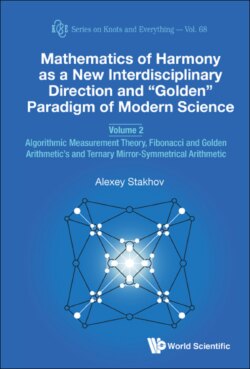Читать книгу Mathematics of Harmony as a New Interdisciplinary Direction and “Golden” Paradigm of Modern Science - Alexey Stakhov - Страница 32
1.10.4. An example of the optimal (n, k, 1)-algorithm
ОглавлениеAs an example, let’s consider the operation of the optimal (3, 3, 1)-algorithm on the initial segment [0, 20] (Fig. 1.11).
Fig. 1.11. The optimal (3, 3, 1)-algorithm.
The optimal (3, 3, 1)-algorithm is realized in the three steps and uses three IE in this case. Note that the number F(3, 3) = 20, which is located at the intersection of the third column and the third row of the arithmetic square (Table 1.1), is equal to the length of the initial uncertainty interval for this algorithm (Table 1.1). The coordinates of the applications of IE in the first step of (3, 3, 1)-algorithm are in the third column of the arithmetic square (Table 1.1) above the number 20 (in bold).
The first step of the (3, 3, 1)-algorithm on the initial segment [0, 20] consists in the enclosing of the three IE to points 1, 4, 10 (Fig. 1.10). After the first step, based on the indications of the IE, four situations may arise (Figs. 1.10(a)–(d)).
The second step: Situation (a): For this situation, the measurement process ends because all the IE are to the right of point X.
Situation (b): For this situation, we have only one IE, which is enclosed to point 2.
Situation (c): For this situation, we have two IE, which are enclosed to points 5 and 7, respectively.
Situation (d): For this situation, we have three IE. In this case, point 10 is the new beginning of the coordinates and three IE are enclosed to points 1, 3, 6 relative to the new beginning of coordinates (point 10). By summing up the numbers 1, 3, 6 to the number 10, we get the coordinates of the enclosed points of three IE at the next step: 11, 13, 16.
After the second step, the following situations may arise: [1, 2], [2, 4], [4, 5], [5, 7], [7, 10], [10, 11], [11, 13], [13, 16], [16, 20]. Note that for situations [1, 2], [4, 5], [10, 11], the measurement process ends at the second step.
The third step: For the situations [2, 4], [5, 7] and [11, 13], the third step is the enclosing of the one IE to points 3, 6, 12, respectively.
For the situations [7, 10] and [13, 16], the third step consists in the enclosing of the two IE to points 8, 9 or 14, 15, respectively.
For the situation [16, 20], the third step consists in the enclosing of the three IE to points 17, 18, 19.
